Solution Manual for Engineering Mechanics Statics and Dynamics 14th Edition by Hibbeler ISBN 0133915425
9780133915426
Full link download: Solution Manua.l: https://testbankpack.com/p/solution-manual-for-engineering-mechanics-statics-anddynamics-14th-edition-by-hibbeler-isbn-0133915425-9780133915426/
3–1.
The members of a truss are pin connected at joint O Determine the magnitudes of F1 and F2 for equilibrium. Set
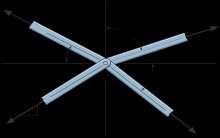

© 2016 Pearson Education, Inc., Upper Saddle River, NJ. All rights reserved. This material is protected under all copyright laws as they currently exist. No portion of this material may be reproduced, in any form or by any means, without permission in writing from the publisher.
© 2016 Pearson Education, Inc., Upper Saddle River, NJ. All rights reserved. This material is protected under all copyright laws as they currently exist. No portion of this material may be reproduced, in any form or by any means, without permission in writing from the publisher.
The members of a truss are pin connected at joint O. y Determine the magnitude of F1 equilibrium.Set F2 = 6 kN.
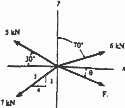
SOLUTION
and its angle
© 2016 Pearson Education, Inc., Upper Saddle River, NJ. All rights reserved. This material is protected under all copyright laws as they currently exist. No portion of this material may be reproduced, in any form or by any means, without permission in writing from the publisher.
© 2016 Pearson Education, Inc., Upper Saddle River, NJ. All rights reserved. This material is protected under all copyright laws as they currently exist. No portion of this material may be reproduced, in any form or by any means, without permission in writing from the publisher.
Determine the magnitude and direction u of F so that the y particle is in equilibrium.
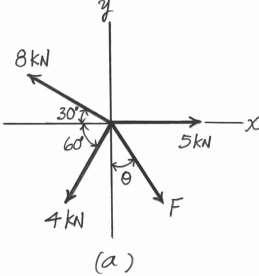
Solution
Equations of Equilibrium. Referring to the FBD shown in Fig a, S + ΣFx = 0; F sin u + 5 - 4 cos 60° - 8 cos 30° = 0 F sin u = 3.9282 (1)
cΣFy = 0; 8 sin 30° - 4 sin 60° - F cos u = 0 F cos u = 0.5359
Divide Eq (1) by (2), sin u cos u = 7.3301 sin u
Realizing that tan u = cos u , then tan u = 7.3301
u = 82.23° = 82.2°
Substitute this result into Eq. (1),
F sin 82.23° = 3.9282
F = 3.9646 kN = 3.96 kN

© 2016 Pearson Education, Inc., Upper Saddle River, NJ. All rights reserved. This material is protected under all copyright laws as they currently exist. No portion of this material may be reproduced, in any form or by any means, without permission in writing from the publisher. © 2016 Pearson Education, Inc., Upper Saddle River, NJ. All rights reserved. This material is protected under all copyright laws as they currently exist. No portion of this material may be reproduced, in any form or by any means, without permission in writing from the publisher.
The bearing consists of rollers, symmetrically confined within the housing The bottom one is subjected to a 125-N force at its contact A due to the load on the shaft. Determine the normal reactions NB and NC on the bearing at its contact points B and C for equilibrium.
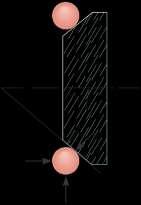





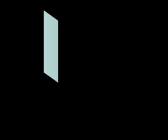

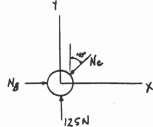
2016 Pearson Education, Inc., Upper Saddle River, NJ. All rights reserved. This material is protected under all copyright laws as they currently exist. No portion of this material may be reproduced, in any form or by any means, without permission in writing from the publisher.
© 2016 Pearson Education, Inc., Upper Saddle River, NJ. All rights reserved. This material is protected under all copyright laws as they currently exist. No portion of this material may be reproduced, in any form or by any means, without permission in writing from the publisher.
The members of a truss are connected to the gusset plate If the forces are concurrent at point O, determine the magnitudes of F and T for equilibrium.Take u = 90°
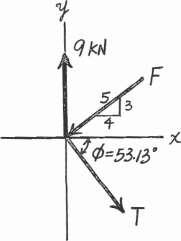



© 2016 Pearson Education, Inc., Upper Saddle River, NJ. All rights reserved. This material is protected under all copyright laws as they currently exist. No portion of this material may be reproduced, in any form or by any means, without permission in writing from the publisher.
© 2016 Pearson Education, Inc., Upper Saddle River, NJ. All rights reserved. This material is protected under all copyright laws as they currently exist. No portion of this material may be reproduced, in any form or by any means, without permission in writing from the publisher. 168168
2016 Pearson Education, Inc., Upper Saddle River, NJ. All rights reserved. This material is protected under all copyright laws as they currently exist. No portion of this material may be reproduced, in any form or by any means, without permission in writing from the publisher. © 2016 Pearson Education, Inc., Upper Saddle River, NJ. All rights reserved. This material is protected under all copyright laws as they currently exist. No portion of this material may be reproduced, in any form or by any means, without permission in writing from the publisher.
The gusset plate is subjected to the forces of three members. Determine the tension force in member C and its angle u for equilibrium. The forces are concurrent at point O. Take




© 2016 Pearson Education, Inc., Upper Saddle River, NJ. All rights reserved. This material is protected under all copyright laws as they currently exist. No portion of this material may be reproduced, in any form or by any means, without permission in writing from the publisher.
© 2016 Pearson Education, Inc., Upper Saddle River, NJ. All rights reserved. This material is protected under all copyright laws as they currently exist. No portion of this material may be reproduced, in any form or by any means, without permission in writing from the publisher.
Ans:
T = 7.66 kN
u = 70.1°
© 2016 Pearson Education, Inc., Upper Saddle River, NJ. All rights reserved. This material is protected under all copyright laws as they currently exist. No portion of this material may be reproduced, in any form or by any means, without permission in writing from the publisher.
C θ
20°
+ R©Fx¿ = 0; 60 cos 10° - T - T cos u = 0

+ Q©Fy¿ = 0; T sin u - 60 sin 10° = 0
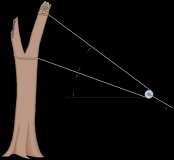
Thus,
T(1 + cos u) = 60 cos 10°
T(2cos2 u ) = 60 cos 10° 2 (1)
u 2T sin 2 u cos 2 = 60 sin 10° (2)
Divide Eq.(2) by Eq.(1)
u tan 2 = tan 10°
u = 20°
Ans
Ans.
© 2016 Pearson Education, Inc., Upper Saddle River, NJ. All rights reserved. This material is protected under all copyright laws as they currently exist. No portion of this material may be reproduced, in any form or by any means, without permission in writing from the publisher. 171171
*3–8.
The cords ABC and BD can each support a maximum load of 100 lb. Determine the maximum weight of the crate, and
the angle u for equilibrium.
Solution
Equations of Equilibrium. Assume that for equilibrium, the tension along the length of rope ABC is constant.Assuming that the tension in cable BD reaches the limit first. Then, TBD = 100 lb. Referring to the FBD shown in Fig a,
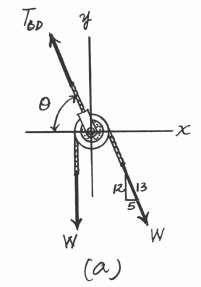
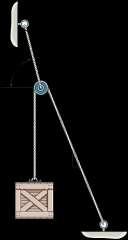
Substitute this result into Eq. (1), 5 100 cos 78.69° = 13 W
W = 50.99 lb = 51.0 lb 6 100 lb (O.K) Ans.
Ans: u = 78.7°
Determine the maximum force F that can be supported in the position shown if each chain can support a maximum
tension of 600 lb before it fails
Solution
Equations of Equilibrium. Referring to the FBD shown in Fig a
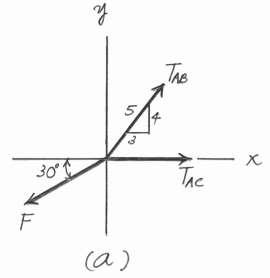
Since chain AB is subjected to a higher tension, its tension will reach the limit first. Thus,

© 2016 Pearson Education, Inc., Upper Saddle River, NJ. All rights reserved. This material is protected under all copyright laws as they currently exist. No portion of this material may be reproduced, in any form or by any means, without permission in writing from the publisher.
© 2016 Pearson Education, Inc., Upper Saddle River, NJ. All rights reserved. This material is protected under all copyright laws as they currently exist. No portion of this material may be reproduced, in any form or by any means, without permission in writing from the publisher.
© 2016 Pearson Education, Inc., Upper Saddle River, NJ. All rights reserved. This material is protected under all copyright laws as they currently exist. No portion of this material may be reproduced, in any form or by any means, without permission in writing from the publisher.
© 2016 Pearson Education, Inc., Upper Saddle River, NJ. All rights reserved. This material is protected under all copyright laws as they currently exist. No portion of this material may be reproduced, in any form or by any means, without permission in writing from the publisher.
3–10.
The block has a weight of 20 lb and is being hoisted at uniform velocity Determine the angle u for equilibrium and B the force in cord AB

Solution
Equations of Equilibrium. Assume that for equilibrium, the tension along the length of cord CAD is constant. Thus, F = 20 lb. Referring to the FBD shown in Fig. a,

S + ΣFx = 0; 20 sin u - TAB sin 20° = 0 20 sin u
TAB = (1) sin 20° +cΣFy = 0; TAB cos 20° - 20 cos u - 20 = 0 (2)
Substitute Eq (1) into (2), 20 sin u sin 20° cos 20° - 20 cos u = 20
sin u cos 20° - cos u sin 20° = sin 20°
Realizing that sin (u - 20°) = sin u cos 20° - cos u sin 20°, then sin (u - 20°) = sin 20°
- 20° = 20°
© 2016 Pearson Education, Inc., Upper Saddle River, NJ. All rights reserved. This material is protected under all copyright laws as they currently exist. No portion of this material may be reproduced, in any form or by any means, without permission in writing from the publisher.
© 2016 Pearson Education, Inc., Upper Saddle River, NJ. All rights reserved. This material is protected under all copyright laws as they currently exist. No portion of this material may be reproduced, in any form or by any means, without permission in writing from the publisher.
Ans:
u = 40°
TAB = 37.6 lb
Determine the maximum weight W of the block that can be suspended in the position shown if cords AB and CAD can each support a maximum tension of 80 lb. Also, what is the angle u for equilibrium?

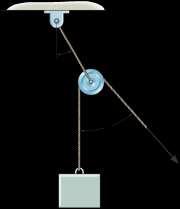
Solution
Equations of Equilibrium. Assume that for equilibrium, the tension along the length of cord CAD is constant. Thus, F = W Assuming that the tension in cord AB reaches the limit first, then TAB = 80 lb Referring to the FBD shown in Fig a,
S + ΣFx = 0; W sin u - 80 sin 20° = 0
80 sin 20° W = (1) sin u
+cΣFy = 0; 80 cos 20° - W - W cos u = 0
80 cos 20°
W = 1 + cos u (2)
Equating Eqs (1) and (2), 80 sin 20° 80 cos 20°
sin u = 1 + cos u
sin u cos 20° - cos u sin 20° = sin 20°
Realizing then sin (u - 20°) = sin u cos 20° - cos u sin 20°, then sin (u - 20°) = sin 20°
u - 20° = 20°
u = 40° Ans.
Substitute this result into Eq (1)
80 sin 20°
W = sin 40° = 42.56 lb = 42.6 lb 6 80 lb (O.K) Ans.
Ans:
© 2016 Pearson Education, Inc., Upper Saddle River, NJ. All rights reserved. This material is protected under all copyright laws as they currently exist. No portion of this material may be reproduced, in any form or by any means, without permission in writing from the publisher.
© 2016 Pearson Education, Inc., Upper Saddle River, NJ. All rights reserved. This material is protected under all copyright laws as they currently exist. No portion of this material may be reproduced, in any form or by any means, without permission in writing from the publisher.
*3–12.
The lift sling is used to hoist a container having a mass of F 500 kg Determine the force in each of the cables AB and AC as a function of u If the maximum tension allowed in
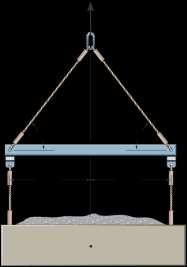
each cable is 5 kN, determine the shortest lengths of cables AB and AC that can be used for the lift. The center of gravity of the container is located at G
SOLUTION
Free-Body Diagram: By observation, the force F1 has to support the entire weight
If the maximum allowable tension in the cable is 5 kN, then
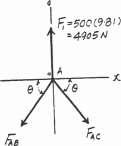
© 2016 Pearson Education, Inc., Upper Saddle River, NJ. All rights reserved. This material is protected under all copyright laws as they currently exist. No portion of this material may be reproduced, in any form or by any means, without permission in writing from the publisher.
© 2016 Pearson Education, Inc., Upper Saddle River, NJ. All rights reserved. This material is protected under all copyright laws as they currently exist. No portion of this material may be reproduced, in any form or by any means, without permission in writing from the publisher.
© 2016 Pearson Education, Inc., Upper Saddle River, NJ. All rights reserved. This material is protected under all copyright laws as they currently exist. No portion of this material may be reproduced, in any form or by any means, without permission in writing from the publisher.
© 2016 Pearson Education, Inc., Upper Saddle River, NJ. All rights reserved. This material is protected under all copyright laws as they currently exist. No portion of this material may be reproduced, in any form or by any means, without permission in writing from the publisher.
3–13.
A nuclear-reactor vessel has a weight of 500(103) lb Determine the horizontal compressive force that the spreader bar AB exerts on point A and the force that each cable segment CA and AD exert on this point while the
vessel is hoisted upward at constant velocity. A
Solution
At point C : S + ΣFx = 0; FCB cos 30° - FCA cos 30° = 0

FCB = FCA +cΣFy = 0; 500(103) - FCA sin 30° - FCB sin 30° = 0 500(103) - 2FCA sin 30° = 0

FCA = 500(103) lb
At point A :
+ ΣFx = 0; 500(103) cos 30° - FAB = 0

FAB = 433(103) lb
+cΣFy = 0; 500(103) sin 30° - FAD = 0
FAD = 500(103) sin 30°
FAD = 250(103) lb
Ans: FCA = 500(103) lb
2016 Pearson Education, Inc., Upper Saddle River, NJ. All rights reserved. This material is protected under all copyright laws as they currently exist. No portion of this material may be reproduced, in any form or by any means, without permission in writing from the publisher. © 2016 Pearson Education, Inc., Upper Saddle River, NJ. All rights reserved. This material is protected under all copyright laws as they currently exist. No portion of this material may be reproduced, in any form or by any means, without permission in writing from the publisher.
Determine the stretch in each spring for equlibrium of the 2-kg block The springs are shown in the equilibrium position.
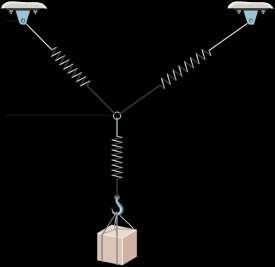

© 2016 Pearson Education, Inc., Upper Saddle River, NJ. All rights reserved. This material is protected under all copyright laws as they currently exist. No portion of this material may be reproduced, in any form or by any means, without permission in writing from the publisher.
© 2016 Pearson Education, Inc., Upper Saddle River, NJ. All rights reserved. This material is protected under all copyright laws as they currently exist. No portion of this material may be reproduced, in any form or by any means, without permission in writing from the publisher.
179179
© 2016 Pearson Education, Inc., Upper Saddle River, NJ. All rights reserved. This material is protected under all copyright laws as they currently exist. No portion of this material may be reproduced, in any form or by any means, without permission in writing from the publisher.
© 2016 Pearson Education, Inc., Upper Saddle River, NJ. All rights reserved. This material is protected under all copyright laws as they currently exist. No portion of this material may be reproduced, in any form or by any means, without permission in writing from the publisher.
The unstretched length of spring AB is 3 m. If the block is held in the equilibrium position shown, determine the mass of the block at D
SOLUTION F = kx = 30(5 - 3) = 60 N
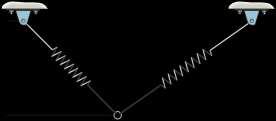
© 2016 Pearson Education, Inc., Upper Saddle River, NJ. All rights reserved. This material is protected under all copyright laws as they currently exist. No portion of this material may be reproduced, in any form or by any means, without permission in writing from the publisher.
© 2016 Pearson Education, Inc., Upper Saddle River, NJ. All rights reserved. This material is protected under all copyright laws as they currently exist. No portion of this material may be reproduced, in any form or by any means, without permission in writing from the publisher.
Ans: m = 8.56 kg
Determine the mass of each of the two cylinders if they cause a sag of s = 0.5 m when suspended from the rings at A and B. Note that s = 0 when the cylinders are removed.


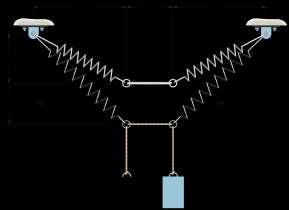
© 2016 Pearson Education, Inc., Upper Saddle River, NJ. All rights reserved. This material is protected under all copyright laws as they currently exist. No portion of this material may be reproduced, in any form or by any means, without permission in writing from the publisher.
© 2016 Pearson Education, Inc., Upper Saddle River, NJ. All rights reserved. This material is protected under all copyright laws as they currently exist. No portion of this material may be reproduced, in any form or by any means, without permission in writing from the publisher.
Ans:
m = 2.37 kg
© 2016 Pearson Education, Inc., Upper Saddle River, NJ. All rights reserved. This material is protected under all copyright laws as they currently exist. No portion of this material may be reproduced, in any form or by any means, without permission in writing from the publisher.
© 2016 Pearson Education, Inc., Upper Saddle River, NJ. All rights reserved. This material is protected under all copyright laws as they currently exist. No portion of this material may be reproduced, in any form or by any means, without permission in writing from the publisher.
3
17.
Determine the stiffness kT of the single spring such that the force F will stretch it by the same amount s as the force F stretches the two springs Express kT in terms of stiffness k1 and k2 of the two springs
2016 Pearson Education, Inc., Upper Saddle River, NJ. All rights reserved. This material is protected under all copyright laws as they currently exist. No portion of this material may be reproduced, in any form or by any means, without permission in writing from the publisher.
3–18.
If the spring DB has an unstretched length of 2 m, determine the stiffness of the spring to hold the 40-kg crate in the position shown.
Solution
Equations of Equilibrium. Referring to the FBD shown in Fig a,
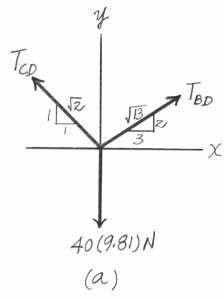
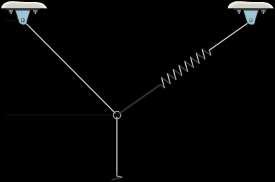
2016 Pearson Education, Inc., Upper Saddle River, NJ. All rights reserved. This material is protected under all copyright laws as they currently exist. No portion of this material may be reproduced, in any form or by any means, without permission in writing from the publisher.
© 2016 Pearson Education, Inc., Upper Saddle River, NJ. All rights reserved. This material is protected under all copyright laws as they currently exist. No portion of this material may be reproduced, in any form or by any means, without permission in writing from the publisher.
3–19.
Determine the unstretched length of DB to hold the 40-kg crate in the position shown. Take k = 180 N>m.
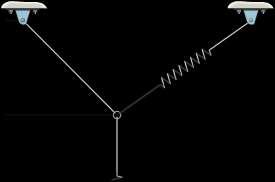
Solution
Equations of Equilibrium. Referring to the FBD shown in Fig. a,

2016 Pearson Education, Inc., Upper Saddle River, NJ. All rights reserved. This material is protected under all copyright laws as they currently exist. No portion of this material may be reproduced, in any form or by any means, without permission in writing from the publisher. © 2016 Pearson Education, Inc., Upper Saddle River, NJ. All rights reserved. This material is protected under all copyright laws as they currently exist. No portion of this material may be reproduced, in any form or by any means, without permission in writing from the publisher.
A vertical force P = 10 lb is applied to the ends of the 2-ft cord AB and spring AC If the spring has an unstretched length of 2 ft, determine the angle u for equilibrium. Take k = 15 lb>ft.
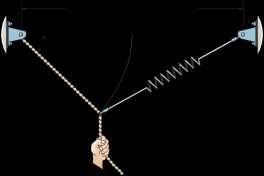


© 2016 Pearson Education, Inc., Upper Saddle River, NJ. All rights reserved. This material is protected under all copyright laws as they currently exist. No portion of this material may be reproduced, in any form or by any means, without permission in writing from the publisher.
© 2016 Pearson Education, Inc., Upper Saddle River, NJ. All rights reserved. This material is protected under all copyright laws as they currently exist. No portion of this material may be reproduced, in any form or by any means, without permission in writing from the publisher.
© 2016 Pearson Education, Inc., Upper Saddle River, NJ. All rights reserved. This material is protected under all copyright laws as they currently exist. No portion of this material may be reproduced, in any form or by any means, without permission in writing from the publisher.
© 2016 Pearson Education, Inc., Upper Saddle River, NJ. All rights reserved. This material is protected under all copyright laws as they currently exist. No portion of this material may be reproduced, in any form or by any means, without permission in writing from the publisher.
3–21.
Determine the unstretched length of spring AC if a force P = 80 lb causes the angle u = 60° for equilibrium. Cord AB is 2 ft long Take k = 50 lb>ft
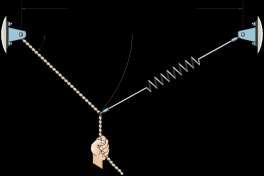

SOLUTION
l = 242 + 22 - 2(2)(4) cos 60°
l = 212
212 2 sin 60° = sin f
f = sin- 1 ¢ 2sin 60° ≤ = 30° 212
+ c ©Fy = 0; T sin 60° + Fs sin 30° - 80 = 0
: + ©Fx = 0; - T cos 60° + Fs cos 30° = 0 Solving for Fs, Fs = 40 lb Fs = kx
The springs BA and BC each have a stiffness of 500 N>m and an unstretched length of 3 m Determine the horizontal force F applied to the cord which is attached to the small ring B so that the displacement of the ring from the wall is d = 1.5 m.
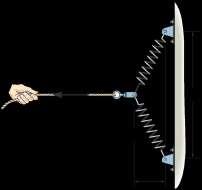

© 2016 Pearson Education, Inc., Upper Saddle River, NJ. All rights reserved. This material is protected under all copyright laws as they currently exist. No portion of this material may be reproduced, in any form or by any means, without permission in writing from the publisher.
3–23.
The springs BA and BC each have a stiffness of 500 N>m and an unstretched length of 3 m Determine the displacement d of the cord from the wall when a force F = 175 N is applied to the cord.
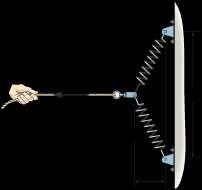
SOLUTION
: + ©Fx = 0; 175 = 2T sin u

T sin u = 87.5
T C 232 2 S = 87.5 + d
T = ks = 500(232 + d2 - 3)
By trial and error:
b
d a13 = 0.175 29 + d2
d = 1.56 m
© 2016 Pearson Education, Inc., Upper Saddle River, NJ. All rights reserved. This material is protected under all copyright laws as they currently exist. No portion of this material may be reproduced, in any form or by any means, without permission in writing from the publisher. 186186
© 2016 Pearson Education, Inc., Upper Saddle River, NJ. All rights reserved. This material is protected under all copyright laws as they currently exist. No portion of this material may be reproduced, in any form or by any means, without permission in writing from the publisher.
© 2016 Pearson Education, Inc., Upper Saddle River, NJ. All rights reserved. This material is protected under all copyright laws as they currently exist. No portion of this material may be reproduced, in any form or by any means, without permission in writing from the publisher. 187187
2016 Pearson Education, Inc., Upper Saddle River, NJ. All rights reserved. This material is protected under all copyright laws as they currently exist. No portion of this material may be reproduced, in any form or by any means, without permission in writing from the publisher. © 2016 Pearson Education, Inc., Upper Saddle River, NJ. All rights reserved. This material is protected under all copyright laws as they currently exist. No portion of this material may be reproduced, in any form or by any means, without permission in writing from the publisher.
*3–24.
Determine the distances x and y for equilibrium if F1 = 800 N and F2 = 1000 N
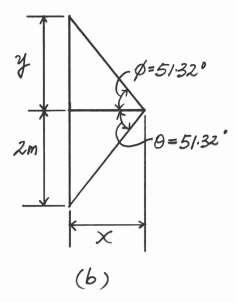
Solution
Equations of Equilibrium. The tension throughout rope ABCD is constant, that is A
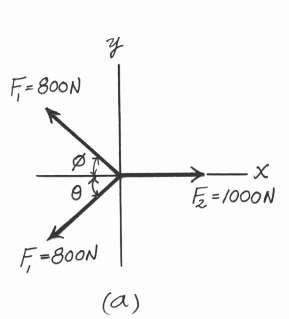
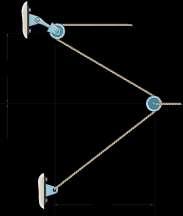
F1 = 800 N. Referring to the FBD shown in Fig. a, x +cΣFy = 0; 800 sin f - 800 sin u = 0 f = 0
S + ΣFx = 0; 1000 - 2[800 cos u] = 0 u = 51.32°
Referring to the geometry shown in Fig b, y = 2 m Ans. and 2 x = tan 51.32°; x = 1.601 m = 1.60 m
